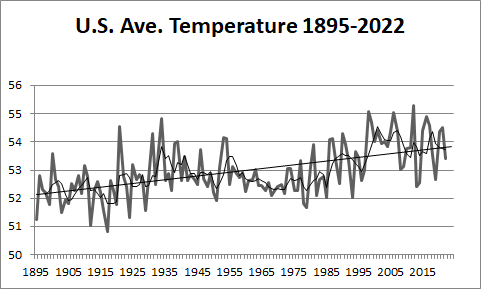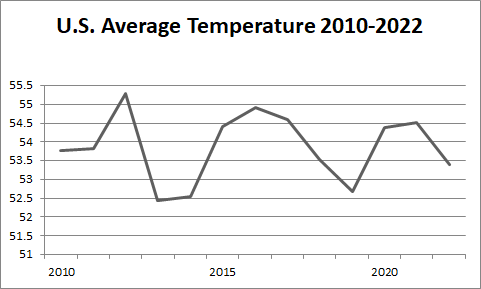Temperature Trends 2022-23
- Bill Hansen
- on Jan, 14, 2023
- No Comments.
TEMPERATURE
The national average temperature indicates a variety of political, social, and life-style trends. During warm trends governments are more centralized. International affairs take precedence over national ones. Federal regulations increase. Prices rise. Moral decadence is unprecedented. During cool trends, individualism replaces group or state control. National affairs become more important than foreign ones. Prices fall and free enterprise reigns.
The graph below depicts annual, average temperatures in the United States from 1895-2022. The dark ‘trend’ line in the middle is a 4-year moving average of the data. Notice that the trend has been going up since the 1970s. Beginning in 1998 temperatures have trended down but are still above average (straight diagonal line) the majority of years. A previous long period of above normal temperatures took place from 1930-1947. The extreme high temperatures resulted in the Dust Bowl of the 30s and the rise of worldwide fascism. The extreme record-breaking weather patterns to date first emerged in the 1990s. Weird weather patterns continue as global warming marches on. The current long-term warming trend is expected to rise by 1.1 – 2.9 degrees by the end of the century according to the Intergovernmental Panel on Climate Change. [Read more about long-range climate change in the article “THE NEW WORLD AGE.”]

It is worth noting the historic highs (the four tall peaks above 540 that have occurred since 1998) are warmer than those in the 1930s. The current period of high warm weather correlates with a worldwide rise in totalitarianism.
The second graph is a closer view of the current temperature trend.

WHAT THE TEMPERATURE TREND FORETELLS
Almost every year since the winter solstice Sun first touched the rim of the galactic equator in 1980 the weather has been berserk. Every year record breaking heat in the summer and frigid winter storms crisscrossed the nation. Unusual and severe droughts, floods, fires, wind and electrical storms have ravaged the country destroying property, displacing and killing humans and other animals. Pestilences will follow. The high yearly temperatures are to blame.
CURRENT YEARS
Warm 2016 continued the liberal agenda of Barack Obama. The November election, however, was a stunning repudiation of Democratic Party policies as the weather turned cooler in 2017. Donald Trump’s victory over Hillary Clinton was a cool surprise. The Republican Party won a majority in the House and the Senate, plus a majority of governorships and state representatives. Suddenly the country flew the nationalist flag and the slogan “Make America Great Again” denoted the new movement. The sharp rise in temperature during 2020 reversed the tumultuous Trump years with Joe Biden winning the election and the Democrats holding the House and taking the evenly split Senate with any tie vote being cast by Vice President Harris. The current warm trend tells us that Biden’s agenda is liberal and progressive. International relations will be emphasized, increased government regulation will be legislated, public works will increase, higher prices and taxes will follow.
Although the long-warm trend of above average temperatures continues, 2012 marked a peak in heat. The following highs in 2016 and 2021 were both a bit cooler than the peak of 2012 giving rise to a slightly more Republican platform during the 2022 midterm election.
THE LONG WARM TREND
Notice in the first graph that a long warm trend started in 1969 even though temperatures did not go much above the average until after 1986. The long warm trend indicates an increase in totalitarianism, bigger and stronger centralized governments, more socialistic programs, the spread of international wars and political scandals, and the rise of autocratic nations like Iran, Russia, and China. The cancerous spread of ISIS and other radical Muslim terrorist organizations is further testimony to the higher temperatures.
Take a look back at how previous long warm trends affected America. During the warm 1880s an economically depressed America witnessed a surge in prejudice and Know-Nothing activism in response to rising immigration. The long warm trend of 1918-1934 witnessed the Great Depression, a major revival of the Ku Klux Klan, and the rise of Fascism in Europe and Japanese Imperialism in Asia. The economically stagnant decades, between the mid-1970s and the mid-1990s, boosted white supremacist groups, anti-government militias, church arsonists, and domestic terrorists. It was also during this current long warm period (1969-present) that Iraq pursued its aggression against Kuwait, which started the Gulf wars and the rise of Muslim terrorism. The Middle East deadlock, especially the one in Afghanistan, promises to be as much a wasted effort for the U.S. as it was to Russia and Great Britain.
Governments will continue to become more powerful and centralized during this warm period. New dictatorships will arise like in Venezuela. Other totalitarian regimes like Syria, North Korea, Iran, Saudi Arabia, and increasingly Russia will cement their power, resist reform movements, and become more absolute in their world-view. The U.S. Federal government will also grow larger and more powerful, reducing the civil rights of American citizens in order to better fight and prepare for domestic terrorists acts. Donald Trump has added his own form of government growth by greatly increasing the national debt through a massive tax cut and military expansion. He has, however, reversed many cumbersome regulatory reforms while also loosing environmental and land-use regulations, some of which may not be in the public’s best interest. The point is that America is increasingly becoming more centralized and socialized no matter which party occupies the White House. Blame the long warm trends.
Prices will rise. Public works projects will be called upon to stimulate slow sectors of the economy and bolster political votes. Large business monopolies will continue to form. Government regulations will increase. Moral decadence, sexual promiscuity, a lethargic populace, and declining health will add to the nature of this long warm trend. And, yet, art will flourish, team sports will be popular, great discoveries and insights will take place by scientists, inventors, and novel thinkers. Abstract theology and mysticism will prevail in the philosophical realm. It is by no means a lost cause, only a change in perspective – a natural and inevitable law of life.
THE DANGER OF INTERNATIONALISM IN THE LONG WARM TREND
The current long-warm trend has undermined a long-standing model of sovereignty. It has become popular for international legal activists to challenge the notion of national sovereignty. The Westphalian model of sovereignty – which dates back to 1648 – states that an independent state is not subject to external control over its internal affairs without its consent. This means that democratic national sovereignty is based on laws that the citizens of a country pass. Modern-day internationalists, however, would like to impose legal mandates on a nation without popular consent. Because this conflicts with the democratic model of government, international law has often been made by way of treaties. Academics, lawyers, and judges who challenge the Westphalian model view it as an antiquated concept. They would argue that international agreements automatically confer legal rights on individuals that may go against the laws of the individuals’ own countries. Some further argue that international law is not limited to what is agreed on by nations in treaties or accepted through widespread practice; they claim it also involves certain “evolving” universal principles.
Universalism, totalitarianism, centralized-state control are most prevalent during long-warm trends. Warm trends threaten democracies. For example, the UN Human Rights Council has passed resolutions urging states to adopt laws combating the “defamation of religions.” This would prohibit the healthy open discussion about religious and political matters that is protected under the First Amendment to the U.S. Constitution. The UN has also held a conference to examine gun-control provisions, ones that would be at odds with the Second Amendment. The UN also passed a resolution calling for a moratorium on capital punishment with “a view to abolishing the death penalty,” even though the U.S. Supreme Court has repeatedly upheld it.
Fortunately, the U.S. Supreme Court has not agreed with these accords. The Court holds that international law must be made with the common consent of the citizens. In recent cases, the Court has held that the United States’ treaty obligations may not always take precedence over domestic legal rules and procedures. International treaty obligations are diplomatic commitments that generally do not become binding domestic law without the consent of Congress.
A one-world government, i.e., universalism, will continue to be a threat to democratic nations in the current long-warm trend. It will take the next long-cool trend to reverse the march toward globalism.
Recent Posts
- A Grand Time
- Financial Forecast 2025
- Temperature Trends 2024-25
- Precipitation Trends 2024-25
- Sunspots 2024-25
Categories
Pages
- Home
- Books
- Home
- Newsletters
- 2020 Triple Alignment
- Black Holes
- I Heard It Through the Grapevine
- Jupiter-Saturn Star Comments
- Jupiter/Pluto 2020: The Great Transition
- Jupiter/Saturn Conjunction 12/21/2020
- More Donald Trump Drama
- More Earthquakes in 2018-2023
- Progressive Policies and the Uranus/Pluto Cycle
- The Star of Impeachment
- Services
- Testimonials
- The Reshaping of America
- The United States Compatibility with President Trump
- Videos
- Your Astrologer
